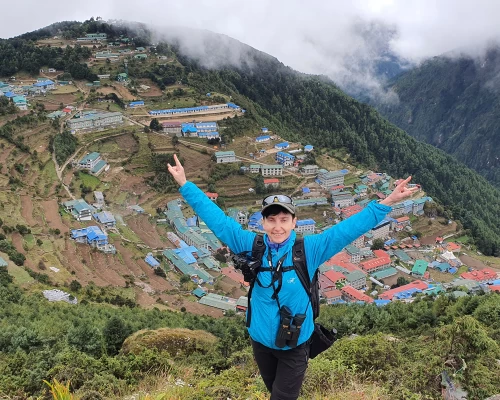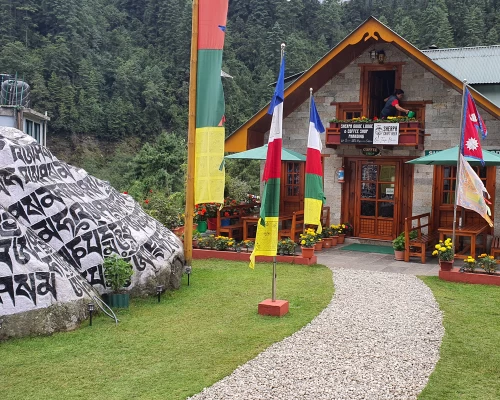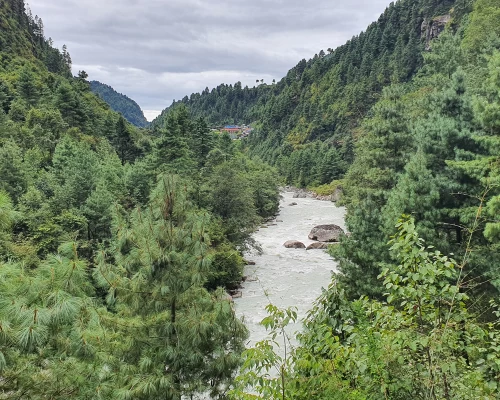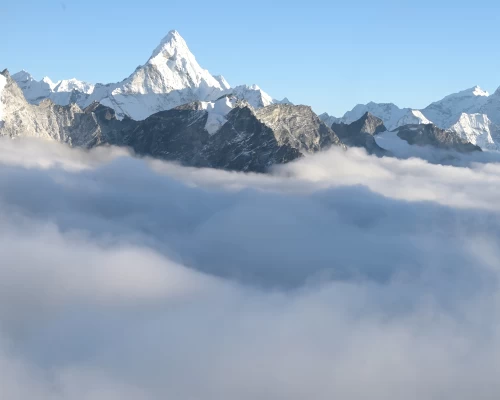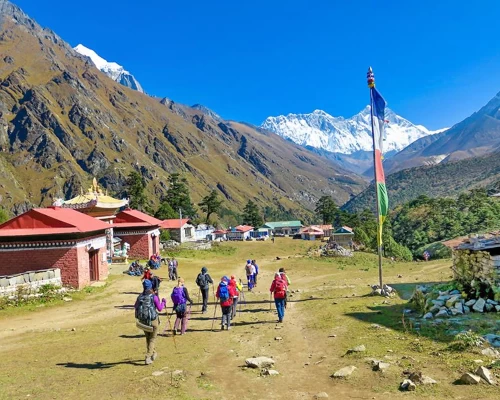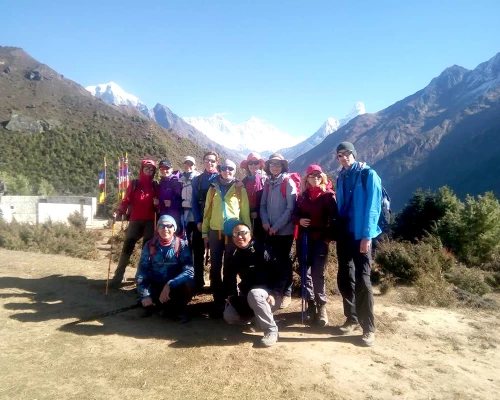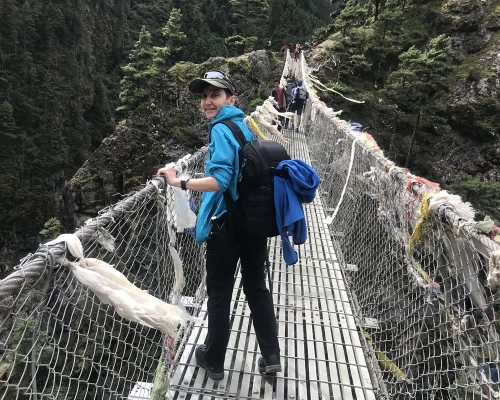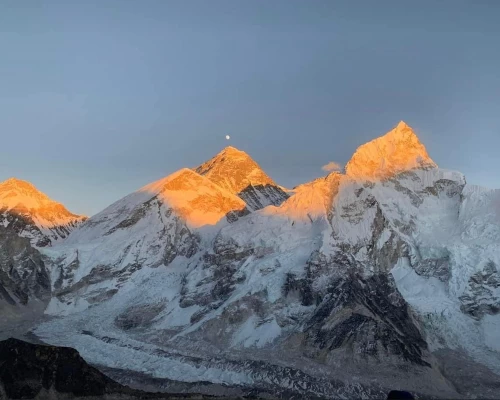Trek Grade

The Everest base camp trek is categorized as a moderate-level difficulty trek that will take you to an elevation of 5,364 meters (17,598 feet). Since the trek starts from an elevation of 2780m and takes you to a base camp at 5,364 meters, it is definitely a huge altitude gain. So, it is obvious it has its own challenges and difficulties.
Moreover, the routes eventually travel through several difficult, steep parts, including stone stairs. Similarly, some travelers may struggle to hike through rocky ridges, river gorges, pasturelands, and wooded areas.
But there aren't any technical parts to this trial, so finishing it won't be too difficult. But the route is quite difficult due to the difficult geography.
Trek Duration
The optimal days to cover the classic Everest trail take about 12 to 16 days; however, you are making this trek without a Lukla flight, so an additional days will take to reach the Solukhumbu district.
Moreover, we provide you with enough days to acclimatize so that you can adjust your temperature according to the altitude. Therefore, this package covers a total of 18 days. Additionally, if you want to make some route variation, then days may be deferred as per those route alterations.
Furthermore, the total distance to be covered is about 130 km, which requires approximately 5 to 7 hours of hiking each day.
Best Season For Everest Base Camp Trekking Without Lukla Flight

Trekking is open for all seasons in Nepal, and Everest base camp is no exception. EBC trek is also available all year round. However, there are two peak seasons for this trek. Trekkers worldwide flog to Nepal for a trek to Everest base camp, mainly in the spring (early March to late May) and autumn seasons( late August to early November).
The Everest region also receives more sunlight during the spring, making the days warmer. The average temperature of the Everest region ranges from 15°C to 22°C. Moreover, during this season, the whole Everest region will be youthful as spring spreads its wings of colors and happiness. The Sagarmatha National Park will be covered with Rhododendron, looking like a beautiful lady draping a red saree.
As you pass through the national park, you will be able to witness many varieties of species like Lophophorus, Musk Deer during this season. The whole forest lights up with blossoms of Rhododendrons along with a clear scenic view of majestic mountains; wow, what a view.
Similarly, autumn is also considered a peak season for EBC treks like spring. The days are milder, with temperatures ranging between 12°C to 18°C. The nights are not too freezing, making it a more suitable climate for trekking. Additionally, the autumn season is considered a festival season in Nepal. You can witness people celebrating Dashian, Tihar, and Chaat and can even join with them to increase their happiness.
Accommodations and Meals

Even though Everest base camp lies in the rural areas of the Himalayan, the trails are well maintained, making it one of the mainstream trekking routes in Nepal.
Foods
Since the Everest base camp trekking is popular worldwide, to accommodate the wide range of tastes of trekkers, teahouse and lodge owners have a variety of cuisine options, including regional food, Tibetan or Indian cuisines with a Nepali touch, or even foreign specialties. Therefore, you dont have to worry in terms of food. On this trail, along with all ascents and descents, you will be able to cleanse your palate with a wide variety of food.
For Breakfast: You can order a hearty breakfast like eggs, bread, pancakes, porridge, cornflakes, soups, etc., to maintain your energy level for the hike and increase your endurance with altitude.
For Lunch and Dinner: You can expect some heavy staples like daal bhaat, tharkari, thakali set, dhindo, thukpa, momos, stews, and other wide variety of food.
Things to remember * As this is a service-oriented package, it doesn't include the food and drinks expenses you should manage by yourself. So make sure that you carry enough cash equivalents, as ATMs are rare in higher elevations. The teahouse or lodge also have nonveg, vegetarian, and even vegan options.
Accommodations
The accommodation in the EBC trail is also well managed. You can find budget-friendly teahouses, lodges, and luxurious hotels, so it can be said that the trail is suitable for all budgets.
If your package is under the regular option, you can expect a room with a twin-sharing bed equipped with comfortable mattresses and pillows. You will be provided additional blankets if you make your package in the off-season. Moreover, the bathroom will be on a shared basis with the western style in lower altitudes, but some bathrooms in higher altitudes may be of traditional style, too.
In case you have a package under other premium options, then you can expect other additional facilities like a hot shower, etc.
Trail Condition/ What is the difficulty level?

Despite the fact that the EBC trek is considered a moderate-level trail, some factors add a certain level of difficulty to the trek.
Altitude sickness
The high altitude of the EBC trip is one of its main obstacles. You will hike to altitudes over 5,000 meters, with a noticeable drop in oxygen. Regardless of fitness level, anybody can experience altitude sickness, which is a serious worry. In order for your body to properly acclimate to the altitude, you must take rest days and ascend gradually.
Steep Terrains
The whole trail comprises ascents and descents, suspension bridges, rocky trails, and moraines to transverse to Everest Base Camp. So, to overcome this difficulty, you should always walk at your own pace and have consistency during the trek. Moreover, while traversing these steep terrains, you will need to keep patience and endurance.
Guides and Porters
Guides and porters are an important part of your EBC journey as they will help with assistance and knowledge during your trek and provide a level of assurance and safety while exploring the base camp. This package will provide you with a helpful, well-equipped porter who will be carrying 15 kg to 25 kg weights; one porter for two people.
Porters will carry your heavy backpack, equipment, and supplies to reduce your load and ease the burden so you can trek easily and comfortably.
Similarly, you can be reassured with a government license holder guide guiding you all in this journey. Guides can be your interpreters who will reduce the language barrier and provide information about the places while navigating the routes. Additionally, these guides are trained in first aid, so they will assist you in emergencies and help with evacuations during accidents or mishaps.
What about Permits?
One of the crucial things you will need to immerse in the beauty of the Himalayas is permits. For the EBC trek, you will need to acquire two permits.
As the Everest base camp lies under the Sagarmatha National Park, you will need to acquire a Sagarmatha National Park Entry Permit. The permit fee for foreign nationals other than SAARC countries is Nrs. 3000, while for the nationals of SAARC countries, it is Nrs. 1500. Similarly, for citizens of Nepal, the permit will cost Rs. 100, excluding VAT. Additionally, children under 10 are allowed for free entrance.
Likewise, the next permit you must acquire is the Khumbu Rural Municipality Permit. This permit costs around US$ 17 for trekkers from outside Nepal and NPR 2,000 for those from SAARC countries.
Passports will be required to obtain both permits. Furthermore, the trekkers arriving from Salleri and Jiri can obtain the Khumbu Permit at the Sagarmatha National Park counter in Monjo while trekkers arriving from Lukla can obtain this permit after arriving at Lukla.
If you are willing to subscribe to our 18-day package, both permits will be included, freeing you from all the hassle.
Dos and Don'ts in EBC Trek
The trail to EBC falls under the supervision of Sagarmatha National Park. So, harming and killing any flora and fauna is strictly prohibited.
Despite the journey being full of rocks and steep terrains, it consists of specific dumping sites and zones, so trekkers need to consider those regions' environmental safety.
Furthermore, the possibility of altitude sickness can strike from around 3000m. Additionally, the elevation gain of more than 300m to 500m in a day is not encouraged in higher altitudes. So, it is very important to have an acclimatization hike to adjust the body to the higher altitude surroundings.
Additionally, it is very important to stay hydrated. So, trekkers need to carry a thermos flask or some stove to heat the water on their way.
Preparation mentally and physically

The EBC trek is one of the long treks, so preparing yourself physically and mentally is a must. You need to learn everything there is to know about the EBC trek, from its difficulties to its altitude and potential weather.
Moreover, it would help if you made yourself psychologically and mentally ready for lengthy hiking days, physical strain, and possible discomfort. So, set reasonable expectations because usually, high expectations can kill joy when not attained.
Additionally, to prepare for trekking, you can begin a regular fitness regimen focusing on strength training and aerobic activities like cycling, running, and hiking. You can also try gradually increasing the time and intensity of your workouts to build up your stamina and endurance.
Preparation For the Trek
Packing for the Everest base camp trek without Lukla flight is based on the season you are trekking. However, you shouldn't miss the essentials.
Clothes:
- Base layers: Breathable, moisture-wicking shirts and bottoms
- Layers of insulation: thermals, thick leggings, and jackets made of fleece.
- Jacket and leggings that are windproof and waterproof on the outside
- Pants for trekking: Long sleeves and lightweight, fast-drying T-shirts
- Warm hat, gloves, and a buff or neck guard
- Liners and hiking socks
Shoes:
- Well-made, cozy, and sturdy hiking boots
- For the evenings and relaxation days, wear lightweight sandals or hiking shoes.
- An additional pair of socks
- Tools and apparatus:
- 40–50 liter backpack with a rain cover
- Trekking poles (collapsible and adjustable)
- Headlamp with additional battery
- UV-blocking sunglasses
- Hydration system or bottle of water
- Eatables and protein bars
- Medication and a personal first-aid kit
- Towel that dries quickly
Optional
- Toiletries (e.g., hand sanitizer, toothpaste, toothbrush, and biodegradable soap)
- High-SPF sunscreen with lip balm
- Repellent for insects
- Electronic gadget converter and portable charger
- Using a smartphone or camera to record memories
- Gaiters (to keep debris and snow out of boots)
- Portable water purifiers or water purifying tablets
- A bandana or buff to shield against dust and wind
- Snacks for trekking or comfort food
Money
While trekking to another country, it's always safe to carry cash or cash equivalents of the same country. You can find plenty of ATMs in Kathmandu that will provide Nepali currency, but on the trail to Everest Base Camp, you will get access to an ATM at Namche Bazaar only. So, it is better to encash when you have enough access to ATMs.
Moreover, the ATMs do accept visas and master cards, but these cards have a limit on each withdrawal. Some shops or cafes may accept those visas and Mastercard, but there will be an additional 3% or 4% charge for each transaction. As you know, the exchange rate varies daily at ATMs and money exchange booths.
Likewise, money changer booths can only change hard currency into Nepali rupees. So, it is better to bring some US dollars, Pounds, Australian Dollars, Singaporean Dollars, Euros, and Malaysian rings for convenience.
Read also:



